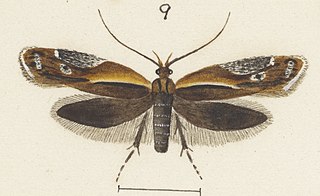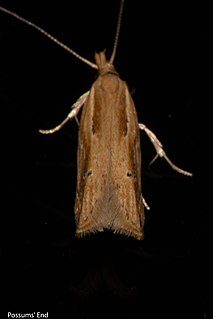
The Depressariinae – sometimes spelled "Depressiinae" in error – are a subfamily of moths in the superfamily Gelechioidea. Like their relatives therein, their exact relationships are not yet very well resolved. It has been considered part of family Elachistidae sensu lato or included in an expanded Oecophoridae. In modern classifications they are treated as the distinct gelechioid family Depressariidae.

Trigonospila brevifacies is a species of true fly in the family Tachinidae native to eastern Australia. This species is also found in New Zealand. Like the vast majority of tachinid flies, T. brevifacies is a parasitoid of other insects, specifically late larval stages of a number of species of Lepidoptera. It is also known as the Australian Leaf-Roller Fly or Leafroller Fly.

Eutorna tricasis is a moth of the family Depressariidae. It is found in Australia, where it has been recorded from the eastern part of the country.

Eutorna is a genus of gelechioid moths.
Eutorna diaula is a moth in the family Depressariidae. It was described by Edward Meyrick in 1906. It is found in Australia, where it has been recorded from Victoria and Tasmania.
Eutorna eurygramma is a moth in the family Depressariidae. It was described by Edward Meyrick in 1906. It is found in Australia, where it has been recorded from Victoria, New South Wales and Tasmania.
Eutorna intonsa is a moth in the family Depressariidae. It was described by Edward Meyrick in 1906. It is found in Australia, where it has been recorded from Victoria, New South Wales and Tasmania.
Eutorna leptographa is a moth in the family Depressariidae. It was described by Edward Meyrick in 1906. It is found in Australia, where it has been recorded from Tasmania.
Eutorna pabulicola is a moth in the family Depressariidae. It was described by Edward Meyrick in 1906. It is found in Australia, where it has been recorded from Queensland and New South Wales.
Eutorna phaulocosma is a moth in the family Depressariidae. It was described by Edward Meyrick in 1906. It is found in Australia, where it has been recorded from Tasmania. It is also found in New Zealand.
Eutorna spintherias is a moth in the family Depressariidae. It was described by Edward Meyrick in 1906. It is found in Australia, where it has been recorded from Victoria and Tasmania.
Eutorna annosa is a moth in the family Depressariidae. It was described by Edward Meyrick in 1936. It is found in China.

Eutorna caryochroa is a species of moth in the family Depressariidae. It was described by Edward Meyrick in 1889 and is endemic to New Zealand. This species is found in both the North and South Islands. The larvae of this species are leaf miners and prefer damp grassland habitat. The adults are on the wing in December and January. They are day flying moths, they frequent forest and scrub, and have a habit of basking on leaves in the sunshine. They have been collected by beating shrubbery.
Eutorna generalis is a moth in the family Depressariidae. It was described by Edward Meyrick in 1921. It is found on Java and in Australia.
Eutorna polismatica is a moth in the family Depressariidae. It was described by Edward Meyrick in 1931. It is found in Japan.

Eutorna symmorpha is a moth in the family Depressariidae. It was described by Edward Meyrick in 1889. It is endemic to New Zealand.

Eutorna inornata is a moth in the family Depressariidae. It was described by Alfred Philpott in 1927. It is endemic to New Zealand and has been observed in both the North and South Islands. The larvae of this moth are leaf minors of Selliera radicans.
Eutorna punctinigrella is a moth in the family Depressariidae. It was described by Pierre Viette in 1955. It is found on Madagascar.
Eutorna rubida is a moth in the family Depressariidae. It was described by Alfred Jefferis Turner in 1919. It is found in Australia, where it has been recorded from Victoria.






